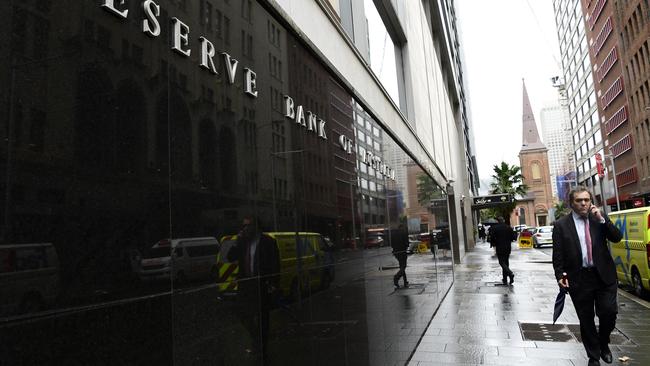Employment fall raises prospects of RBA interest rate cut
The biggest monthly fall in employment in the past three years has refocused markets on the potential for further rate cuts.

The biggest monthly fall in employment in the past three years and a consequent rise in the unemployment rate has refocused financial markets on the potential for further interest rate cuts to achieve the Reserve Bank’s goals of full employment and inflation in line with its target.
The market-implied chance of the RBA cutting its official cash rate by 25 basis points to a record low of 0.5 per cent by May next year jumped to 94 per cent, from 73 per cent, after October labour force data revealed a disappointing 19,000 fall in employment and 5.3 per cent unemployment rate.
It was the first significant fall in employment since September 2016, and much weaker than a 15,000 rise expected by economists. The unemployment rate had been expected to stay at 5.2 per cent. It would have been higher than 5.3 per cent if not for a fall in the participation rate to 66 per cent, from 66.1 per cent.
The dollar subsequently dived while bonds rallied, along with shares.
The dollar fell 0.6 per cent to a four-week low of US67.95c, 10-year bond yields fell 10 basis points to 1.18 per cent and the S&P/ASX 200 share index rose 0.6 per cent to 6735.1 points.
While the unemployment rate remains near the RBA’s forecast of 5.2 per cent through 2020, it is well above the “full employment” or “non-accelerating inflation rate of unemployment” — currently estimated by the central bank to be about 4.5 per cent — that it is aiming to achieve by keeping interest rates low and easing monetary policy further if needed.
More importantly, a worsening labour market is contrary to the RBA’s assertion that, “after a soft patch in the second half of last year, a gentle turning point appears to have been reached”.
At a minimum, it supports the RBA’s view that “it is reasonable to expect an extended period of low interest rates will be required ... to reach full employment and achieve the inflation target”.
In its statement this month, the RBA said it would “continue to monitor developments, including in the labour market, and is prepared to ease monetary policy further if needed to support sustainable growth in the economy, full employment and the achievement of the inflation target over time”.
JPMorgan senior economist Ben Jarman said the jobs data was subject to some “noisy factors” and his modelling still suggested unemployment would drift “a bit lower” over the next six months, but the RBA would nevertheless remain some distance from its goals, requiring further easing.
“The improvement (forecast) in the outlook for the labour market is modest, and the RBA’s estimate of NAIRU still looks quite some distance away,” Mr Jarman said.
Capital Economics senior economist Ben Udy was more cautious. He argued that, while NAB’s business survey points to annual jobs growth bouncing back up to 2.5 per cent next year after falling to 2 per cent in October, declining job vacancies suggested employment growth may slow close to 1 per cent, which would be in line with the weakness in economic activity.
“While job advertisements haven’t fallen much further in recent months, they still point to a jobless rate of around 5.5 per cent, as do households’ unemployment expectations,” Mr Udy said.
“We reiterate our forecast that the unemployment rate will climb to 5.5 per cent by early next year which should force the RBA to cut rates to 0.5 per cent in February.
“Given our expectation that weaker wage growth will result in inflation falling further below the RBA’s target, we don’t think the bank will stop there.”
Similarly, Westpac senior economist Justin Smirk said that, with leading indicators pointing to softer employment growth, he remained comfortable with his view that a resilient participation rate would result in the unemployment rate continuing its gradual trend higher to 5.6 per cent by mid-2020.
“The economy is a long way away from the RBA’s full employment aim of 4.5 per cent and if the bank wants to use monetary policy to drive the economy in that direction, it has a lot more work to do,” Mr Smirk said.
“However, the gradual pace of the deterioration will allow the RBA time to monitor the economy before having to act again.”
In his view, while rate cuts along with the government’s tax offset payments should help support demand, it will be insufficient to get economic growth moving back to trend or above next year.
AMP Capital chief economist Shane Oliver said a rising trend in unemployment and underemployment this year showed that “spare capacity” was high and increasing. Underemployment — which includes employed people who want and are available for more hours of work than they have — rose to 8.8 per cent, from 8.5 per cent.
“Against this background it’s hard to see wages growth improving any time soon,” he said.
With RBA rate cuts and tax cuts to date insufficient to lower unemployment to levels needed to boost wages and inflation, Dr Oliver said fiscal stimulus — including faster tax cuts, a boost to Newstart, investment incentives and earlier infrastructure spending where possible — was “needed from here”.
Dr Oliver expected rate cuts, quantitative easing — possibly designed to lower bank funding costs and allow banks to pass on more of rate cuts — and more dovish forward guidance from the RBA.




To join the conversation, please log in. Don't have an account? Register
Join the conversation, you are commenting as Logout